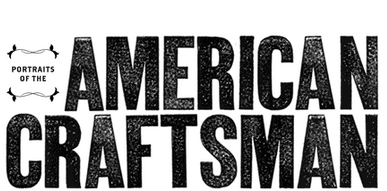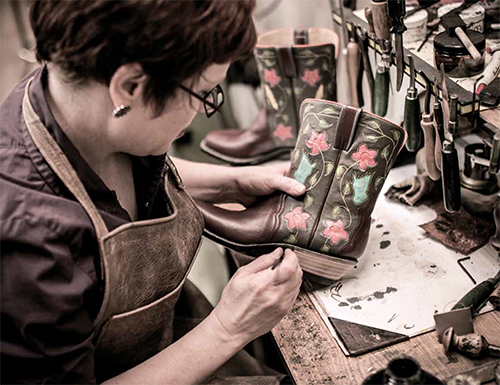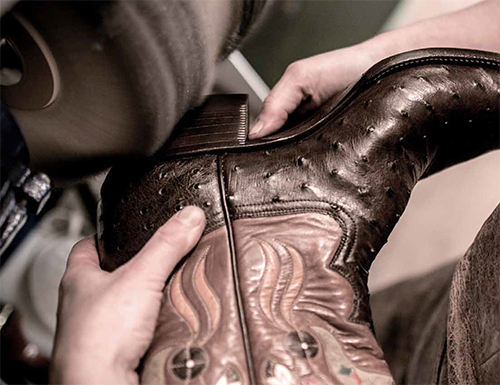Sorrell Custom Boots: the art of the boot.
Lisa Sorrell spent decades becoming an overnight success.
From the age of fifteen, Sorrell sewed for women in her small Missouri church. She got married, moved to Oklahoma, and took up boot making as an apprentice. Then in 1996, when she was two months pregnant, she opened her own shop. Three years later she was featured in the influential book The Art of the Boot, which gave her and her boots some unexpected fame.
Sorrell could make any and all styles of men’s and women’s boots. But because of the book, she would become most known for her intricately stitched works.
“It helped my career take off,” Sorrell says. “It was the first thing that made me realize I could define myself, because after it came out, everyone wanted the boots they featured in it: the fancy, intricate designs.”
Sorrell recognizes the value of the serendipity that led to her current success. “I wasn’t raised cowboy at all,” she says. “I’d never worn boots. What attracted me was the craft. And that I could sew, create designs, hammer, and make things for both men and women.” In her church, Sorrell says, “Girls did girl things, boys did boy things. I didn’t like that.”
Now the process is the same for men and women. She meets and measures all her customers at Sorrell Custom Boots, asks them what they’re looking for, and takes inspiration from what they say.
Then she begins the process by creating a wooden “last”—a form of the customer’s foot. (“The last is first,” as boot makers say.) Once the last is fit, Sorrell draws her pattern on poster board so she has the exact size and dimensions that the leather needs to be.
After the leather is cut, she can do decorative work on the boot’s tops. She’ll shape the vamp (the part that covers the foot)—crimp, stretch, and fight with it as needed. The rest of the boot’s leather requires only gentle folding before the parts are sewn together and the sole and heel are added.
Sorrell has slowed down her production in recent years, as the practice has taken a toll on her hands. “When I first started, it was all about getting it done getting a paycheck,” she says. “Now I’m trying to slow down and enjoy the craft, and put that passion and love into my work now.”
When she first got into boot making, she says, it was the art that spoke most clearly to her. But at the time it was not appropriate to speak of such real-world poetry. Now she feels more confident and has no problem talking about the less-than-practical aspects of her life and work.
Like how she fell in love with the sound of an American straight-needle machine the first time she heard it hum and clack. Like how the sound her shop’s machines make soothes her daughter, who heard those sounds in the womb, long before Lisa Sorrell was famous for her intricately stitched boots—years before she became an overnight success.





